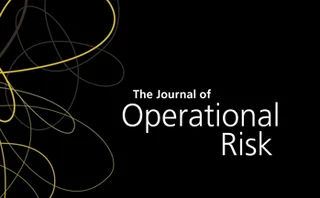Technical paper/Risk
Modeling realized volatility with implied volatility for the EUR/GBP exchange rate
This paper concerns the application of implied volatility in modeling realized volatility in the daily, weekly and monthly horizon using high-frequency data for the EUR/GBP exchange rate.
Optimal foreign exchange hedge tenor with liquidity risk
The authors develop an optimal currency hedging strategy that allows fund managers who own foreign assets to choose the hedge tenors that will maximize their foreign exchange carry returns within a liquidity risk constraint.
Optimization of systemic risk: reallocation of assets based on bank networks
In this paper, the authors investigate the optimization of systemic risk based on DebtRank by considering two contagion channels: interbank lending and common asset holdings.
A review of the foreign exchange base currency approach under the standardized approach of the Fundamental Review of the Trading Book and issues related to the pegged reporting currency
When we adopt the parameters in the BCBS standards to calculate the delta risk charge, anomalies in the risk charges for the same risk exposure are found under different approaches and under different reporting currencies. The anomalies increase when the…
Forecasting Bitcoin returns: is there a role for the US–China trade war?
In this paper, the authors extend the related literature by examining whether the information on the US–China trade war can be used to forecast the future path of Bitcoin returns, controlling for various explanatory variables.
Standard errors of risk and performance estimators for serially dependent returns
In this paper, a new method for computing the standard errors (SEs) of returns-based risk and performance estimators for serially dependent returns is developed.
Modeling loss given default regressions
The authors investigate the puzzle in the literature that various parametric loss given default (LGD) statistical models perform similarly, by comparing their performance in a simulation framework.
Monetary policy uncertainty and jumps in advanced equity markets
The authors analyze the role of monetary policy uncertainty in predicting jumps in nine advanced equity markets.
Optimal reinsurance with expectile under the Vajda condition
In this paper, the author revisits optimal reinsurance problems by minimizing the adjusted value of the liability of an insurer, which encompasses a risk margin. The risk margin is determined by expectile.
Evaluating cyclic risk propagation through an organization
Many large organizations have risk that propagates because of the dependencies between their various major organizational components. This paper addresses when cycles of dependencies exist in an organization or system of systems.
The impact of corporate social and environmental performance on credit rating prediction: North America versus Europe
The authors quantify the extent to which the quality of credit rating predictions improves by integrating measures of corporate social performance (CSP) in an established credit risk model. Their analysis provides comprehensive evidence of the…
Fund size and the stability of portfolio risk
This paper examines the relationship between portfolio size and the stability of mutual fund risk measures, presenting evidence for economies of scale in risk management.
Economic policy uncertainty, investors’ attention and US real estate investment trusts’ herding behaviors
Using a quantile regression model, this study examines economic policy uncertainty and investors’ attention for policy risk on US real estate investment trusts’ (REITs’) herding behaviors.
The econophysics of asset prices, returns and multiple expectations
The author models interactions between financial transactions and expectations and describe asset pricing and return disturbances.
Strategic and technology risks: the case of Co-operative Bank
This paper studies the growth by acquisition strategy embarked upon by a mid-sized UK bank, the Co-operative Bank; this strategy was a disaster, leaving a heretofore successful bank in dire trouble and on the block for buyers at a substantial discount to…
Volatility spillover along the supply chains: a network analysis on economic links
The analysis in this paper reveals that additional fundamental risk gets transferred along supply chains, and that suppliers are exposed to additional fundamental risk that is not captured by their market beta. Suppliers are therefore exposed to…
Integrating macroeconomic variables into behavioral models for interest rate risk measurement in the banking book
This paper proposed a nonparametric approach to decompose a macroeconomic variable into an interest-rate-correlated component and a macro-specific component.
Range-based volatility forecasting: a multiplicative component conditional autoregressive range model
This paper proposes a multiplicative component CARR (MCCARR) model to capture the "long-memory" effect in volatility.
Near-real-time monitoring in real-time gross settlement systems: a traffic light approach
This paper develops a method to identify quantitative risks in financial market infrastructures (FMIs) that is inspired by the Principles for Financial Market Infrastructures.
Empirical analysis of oil risk-minimizing portfolios: the DCC–GARCH–MODWT approach
This paper strives to analyze hedging strategies between Brent oil and six other het- erogeneous assets – American ten-year bonds, US dollars, gold, natural gas futures, corn futures, and Europe, Australasia and Far East exchange-traded funds (EAFE- ETFs…
Crash risk exposure, diversification and cost of equity capital: evidence from a natural experiment in China
Based on a broad sample of Chinese listed firms for the period 2001–10, this study investigates the effect of stock price crash risk exposure on the cost of equity capital and uses the split share structure reform as an exogenous shock to test whether…
The impact of enterprise risk management on the performance of companies in transition countries: Serbia case study
In this paper, seven hypotheses are defined, on the basis of which a theoretical model is developed to examine how different sources of enterprise risk affect the operational performance of Serbian companies and their risk of losing market position.
Measuring the systemic risk of China’s banking sector: an application of differential DebtRank
This paper investigates the systemic risk of China’s banking sector via network analysis and differential DebtRank from 2007 to 2016.
Static and dynamic risk capital allocations with the Euler rule
This paper studies the volatility of the Euler rule for capital allocation in static and dynamic empirical applications with a simulated history.



